Comparative Analysis of Media Censorship in China and Israel
VerifiedAdded on 2021/04/16
|7
|1768
|151
Essay
AI Summary
This essay provides a comparative analysis of media censorship practices in China and Israel. It explores the distinct motivations behind censorship in each country, highlighting the role of political and religious factors. The essay examines how China employs censorship for political control, including the monitoring of online content and the enforcement of self-regulation by internet companies. In contrast, it discusses Israel's approach, which is influenced by religious beliefs and national security concerns, and how it seeks to control media and journalism. The analysis also considers the challenges both countries face in implementing censorship, including issues of legitimacy and public discontent. The essay concludes by emphasizing the importance of understanding the different motives behind censorship to gain a comprehensive understanding of the issue.
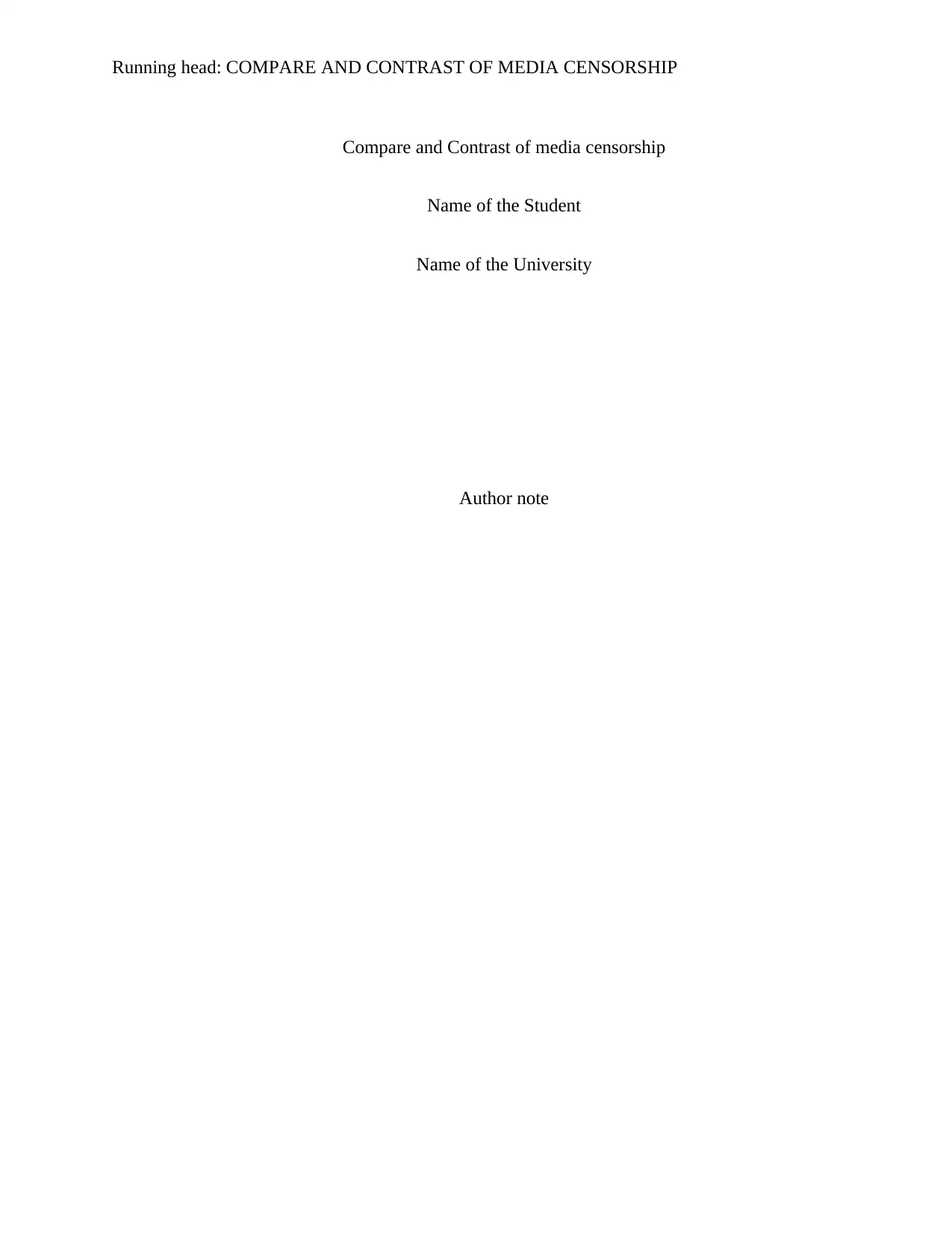
Running head: COMPARE AND CONTRAST OF MEDIA CENSORSHIP
Compare and Contrast of media censorship
Name of the Student
Name of the University
Author note
Compare and Contrast of media censorship
Name of the Student
Name of the University
Author note
Paraphrase This Document
Need a fresh take? Get an instant paraphrase of this document with our AI Paraphraser
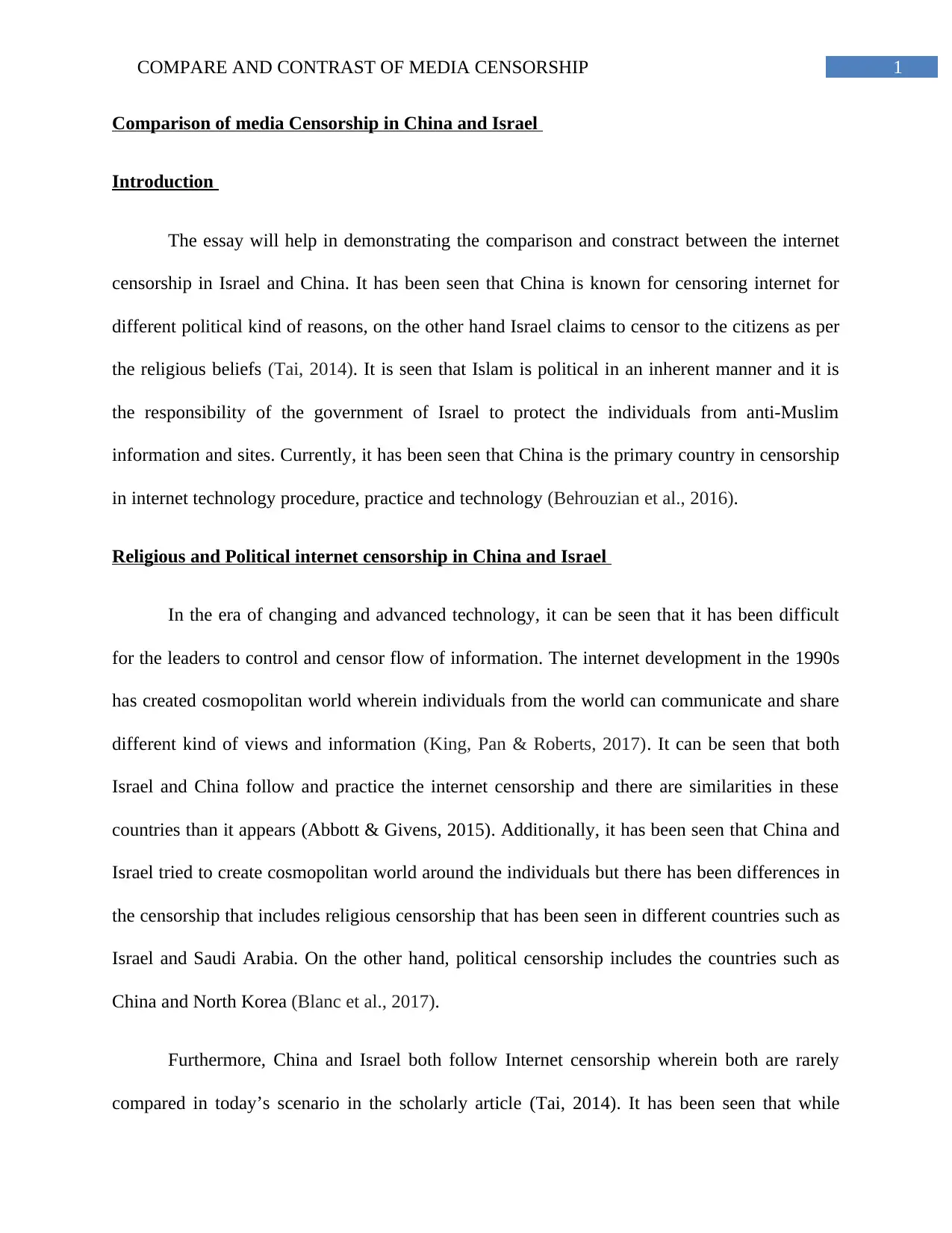
1COMPARE AND CONTRAST OF MEDIA CENSORSHIP
Comparison of media Censorship in China and Israel
Introduction
The essay will help in demonstrating the comparison and constract between the internet
censorship in Israel and China. It has been seen that China is known for censoring internet for
different political kind of reasons, on the other hand Israel claims to censor to the citizens as per
the religious beliefs (Tai, 2014). It is seen that Islam is political in an inherent manner and it is
the responsibility of the government of Israel to protect the individuals from anti-Muslim
information and sites. Currently, it has been seen that China is the primary country in censorship
in internet technology procedure, practice and technology (Behrouzian et al., 2016).
Religious and Political internet censorship in China and Israel
In the era of changing and advanced technology, it can be seen that it has been difficult
for the leaders to control and censor flow of information. The internet development in the 1990s
has created cosmopolitan world wherein individuals from the world can communicate and share
different kind of views and information (King, Pan & Roberts, 2017). It can be seen that both
Israel and China follow and practice the internet censorship and there are similarities in these
countries than it appears (Abbott & Givens, 2015). Additionally, it has been seen that China and
Israel tried to create cosmopolitan world around the individuals but there has been differences in
the censorship that includes religious censorship that has been seen in different countries such as
Israel and Saudi Arabia. On the other hand, political censorship includes the countries such as
China and North Korea (Blanc et al., 2017).
Furthermore, China and Israel both follow Internet censorship wherein both are rarely
compared in today’s scenario in the scholarly article (Tai, 2014). It has been seen that while
Comparison of media Censorship in China and Israel
Introduction
The essay will help in demonstrating the comparison and constract between the internet
censorship in Israel and China. It has been seen that China is known for censoring internet for
different political kind of reasons, on the other hand Israel claims to censor to the citizens as per
the religious beliefs (Tai, 2014). It is seen that Islam is political in an inherent manner and it is
the responsibility of the government of Israel to protect the individuals from anti-Muslim
information and sites. Currently, it has been seen that China is the primary country in censorship
in internet technology procedure, practice and technology (Behrouzian et al., 2016).
Religious and Political internet censorship in China and Israel
In the era of changing and advanced technology, it can be seen that it has been difficult
for the leaders to control and censor flow of information. The internet development in the 1990s
has created cosmopolitan world wherein individuals from the world can communicate and share
different kind of views and information (King, Pan & Roberts, 2017). It can be seen that both
Israel and China follow and practice the internet censorship and there are similarities in these
countries than it appears (Abbott & Givens, 2015). Additionally, it has been seen that China and
Israel tried to create cosmopolitan world around the individuals but there has been differences in
the censorship that includes religious censorship that has been seen in different countries such as
Israel and Saudi Arabia. On the other hand, political censorship includes the countries such as
China and North Korea (Blanc et al., 2017).
Furthermore, China and Israel both follow Internet censorship wherein both are rarely
compared in today’s scenario in the scholarly article (Tai, 2014). It has been seen that while
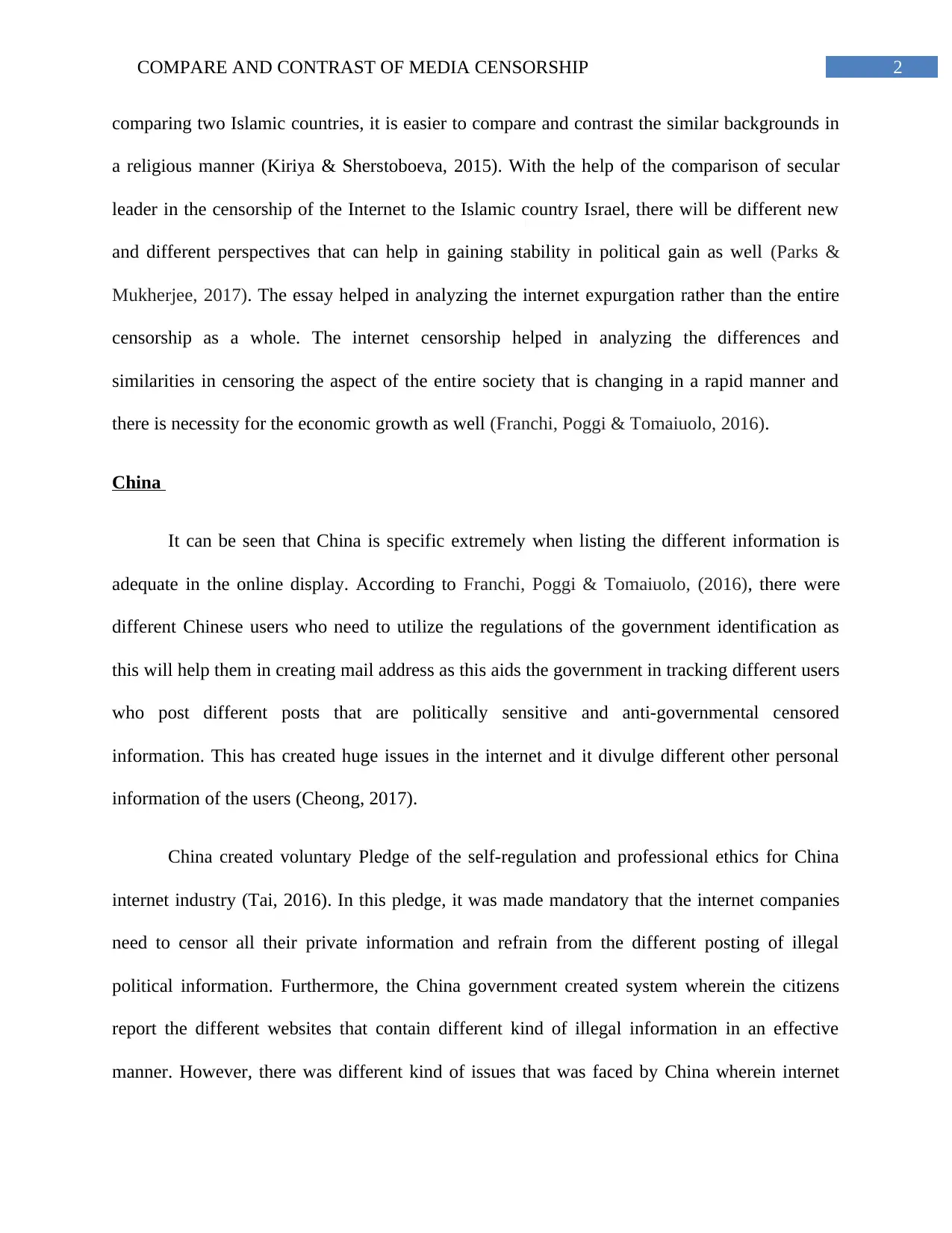
2COMPARE AND CONTRAST OF MEDIA CENSORSHIP
comparing two Islamic countries, it is easier to compare and contrast the similar backgrounds in
a religious manner (Kiriya & Sherstoboeva, 2015). With the help of the comparison of secular
leader in the censorship of the Internet to the Islamic country Israel, there will be different new
and different perspectives that can help in gaining stability in political gain as well (Parks &
Mukherjee, 2017). The essay helped in analyzing the internet expurgation rather than the entire
censorship as a whole. The internet censorship helped in analyzing the differences and
similarities in censoring the aspect of the entire society that is changing in a rapid manner and
there is necessity for the economic growth as well (Franchi, Poggi & Tomaiuolo, 2016).
China
It can be seen that China is specific extremely when listing the different information is
adequate in the online display. According to Franchi, Poggi & Tomaiuolo, (2016), there were
different Chinese users who need to utilize the regulations of the government identification as
this will help them in creating mail address as this aids the government in tracking different users
who post different posts that are politically sensitive and anti-governmental censored
information. This has created huge issues in the internet and it divulge different other personal
information of the users (Cheong, 2017).
China created voluntary Pledge of the self-regulation and professional ethics for China
internet industry (Tai, 2016). In this pledge, it was made mandatory that the internet companies
need to censor all their private information and refrain from the different posting of illegal
political information. Furthermore, the China government created system wherein the citizens
report the different websites that contain different kind of illegal information in an effective
manner. However, there was different kind of issues that was faced by China wherein internet
comparing two Islamic countries, it is easier to compare and contrast the similar backgrounds in
a religious manner (Kiriya & Sherstoboeva, 2015). With the help of the comparison of secular
leader in the censorship of the Internet to the Islamic country Israel, there will be different new
and different perspectives that can help in gaining stability in political gain as well (Parks &
Mukherjee, 2017). The essay helped in analyzing the internet expurgation rather than the entire
censorship as a whole. The internet censorship helped in analyzing the differences and
similarities in censoring the aspect of the entire society that is changing in a rapid manner and
there is necessity for the economic growth as well (Franchi, Poggi & Tomaiuolo, 2016).
China
It can be seen that China is specific extremely when listing the different information is
adequate in the online display. According to Franchi, Poggi & Tomaiuolo, (2016), there were
different Chinese users who need to utilize the regulations of the government identification as
this will help them in creating mail address as this aids the government in tracking different users
who post different posts that are politically sensitive and anti-governmental censored
information. This has created huge issues in the internet and it divulge different other personal
information of the users (Cheong, 2017).
China created voluntary Pledge of the self-regulation and professional ethics for China
internet industry (Tai, 2016). In this pledge, it was made mandatory that the internet companies
need to censor all their private information and refrain from the different posting of illegal
political information. Furthermore, the China government created system wherein the citizens
report the different websites that contain different kind of illegal information in an effective
manner. However, there was different kind of issues that was faced by China wherein internet
⊘ This is a preview!⊘
Do you want full access?
Subscribe today to unlock all pages.

Trusted by 1+ million students worldwide
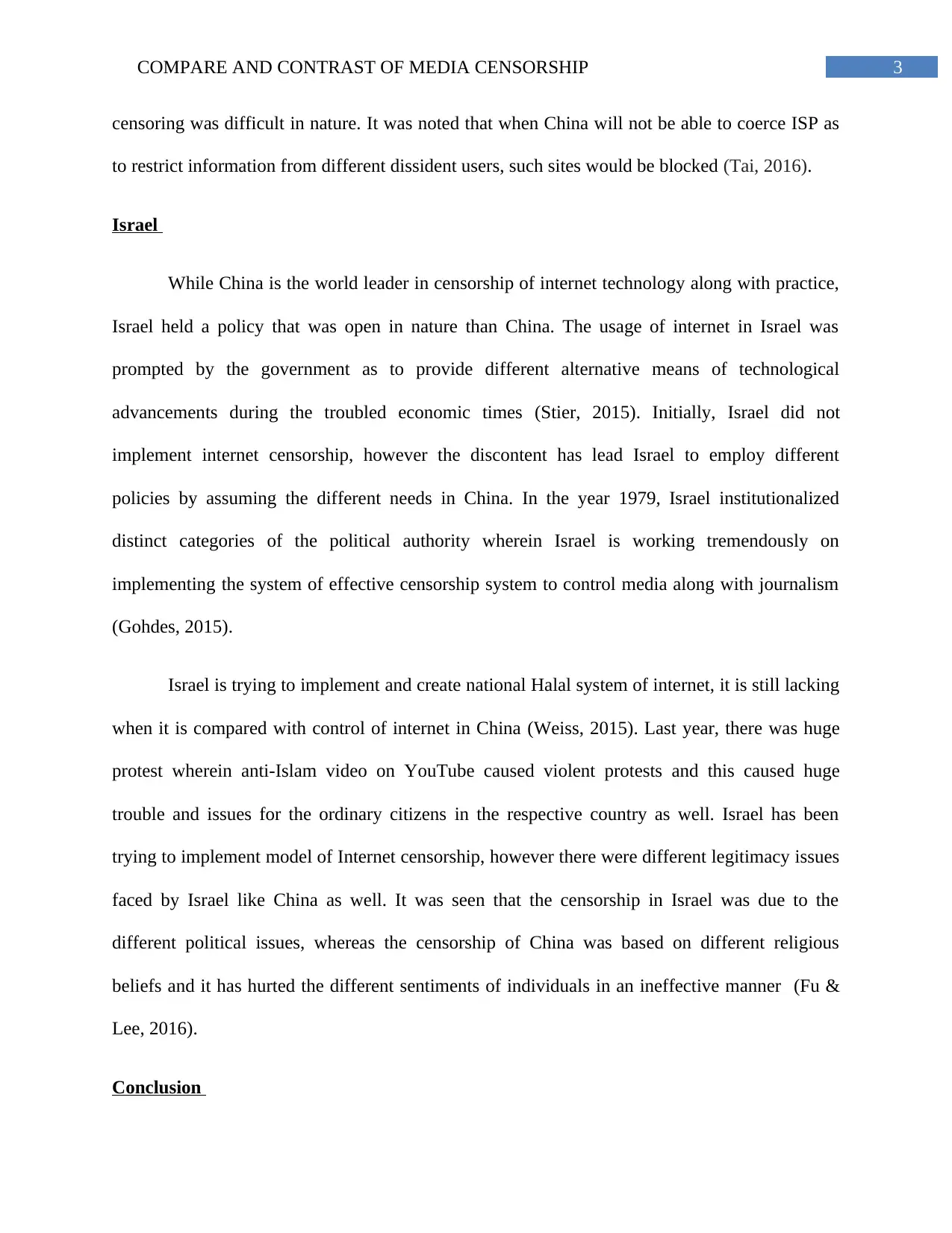
3COMPARE AND CONTRAST OF MEDIA CENSORSHIP
censoring was difficult in nature. It was noted that when China will not be able to coerce ISP as
to restrict information from different dissident users, such sites would be blocked (Tai, 2016).
Israel
While China is the world leader in censorship of internet technology along with practice,
Israel held a policy that was open in nature than China. The usage of internet in Israel was
prompted by the government as to provide different alternative means of technological
advancements during the troubled economic times (Stier, 2015). Initially, Israel did not
implement internet censorship, however the discontent has lead Israel to employ different
policies by assuming the different needs in China. In the year 1979, Israel institutionalized
distinct categories of the political authority wherein Israel is working tremendously on
implementing the system of effective censorship system to control media along with journalism
(Gohdes, 2015).
Israel is trying to implement and create national Halal system of internet, it is still lacking
when it is compared with control of internet in China (Weiss, 2015). Last year, there was huge
protest wherein anti-Islam video on YouTube caused violent protests and this caused huge
trouble and issues for the ordinary citizens in the respective country as well. Israel has been
trying to implement model of Internet censorship, however there were different legitimacy issues
faced by Israel like China as well. It was seen that the censorship in Israel was due to the
different political issues, whereas the censorship of China was based on different religious
beliefs and it has hurted the different sentiments of individuals in an ineffective manner (Fu &
Lee, 2016).
Conclusion
censoring was difficult in nature. It was noted that when China will not be able to coerce ISP as
to restrict information from different dissident users, such sites would be blocked (Tai, 2016).
Israel
While China is the world leader in censorship of internet technology along with practice,
Israel held a policy that was open in nature than China. The usage of internet in Israel was
prompted by the government as to provide different alternative means of technological
advancements during the troubled economic times (Stier, 2015). Initially, Israel did not
implement internet censorship, however the discontent has lead Israel to employ different
policies by assuming the different needs in China. In the year 1979, Israel institutionalized
distinct categories of the political authority wherein Israel is working tremendously on
implementing the system of effective censorship system to control media along with journalism
(Gohdes, 2015).
Israel is trying to implement and create national Halal system of internet, it is still lacking
when it is compared with control of internet in China (Weiss, 2015). Last year, there was huge
protest wherein anti-Islam video on YouTube caused violent protests and this caused huge
trouble and issues for the ordinary citizens in the respective country as well. Israel has been
trying to implement model of Internet censorship, however there were different legitimacy issues
faced by Israel like China as well. It was seen that the censorship in Israel was due to the
different political issues, whereas the censorship of China was based on different religious
beliefs and it has hurted the different sentiments of individuals in an ineffective manner (Fu &
Lee, 2016).
Conclusion
Paraphrase This Document
Need a fresh take? Get an instant paraphrase of this document with our AI Paraphraser
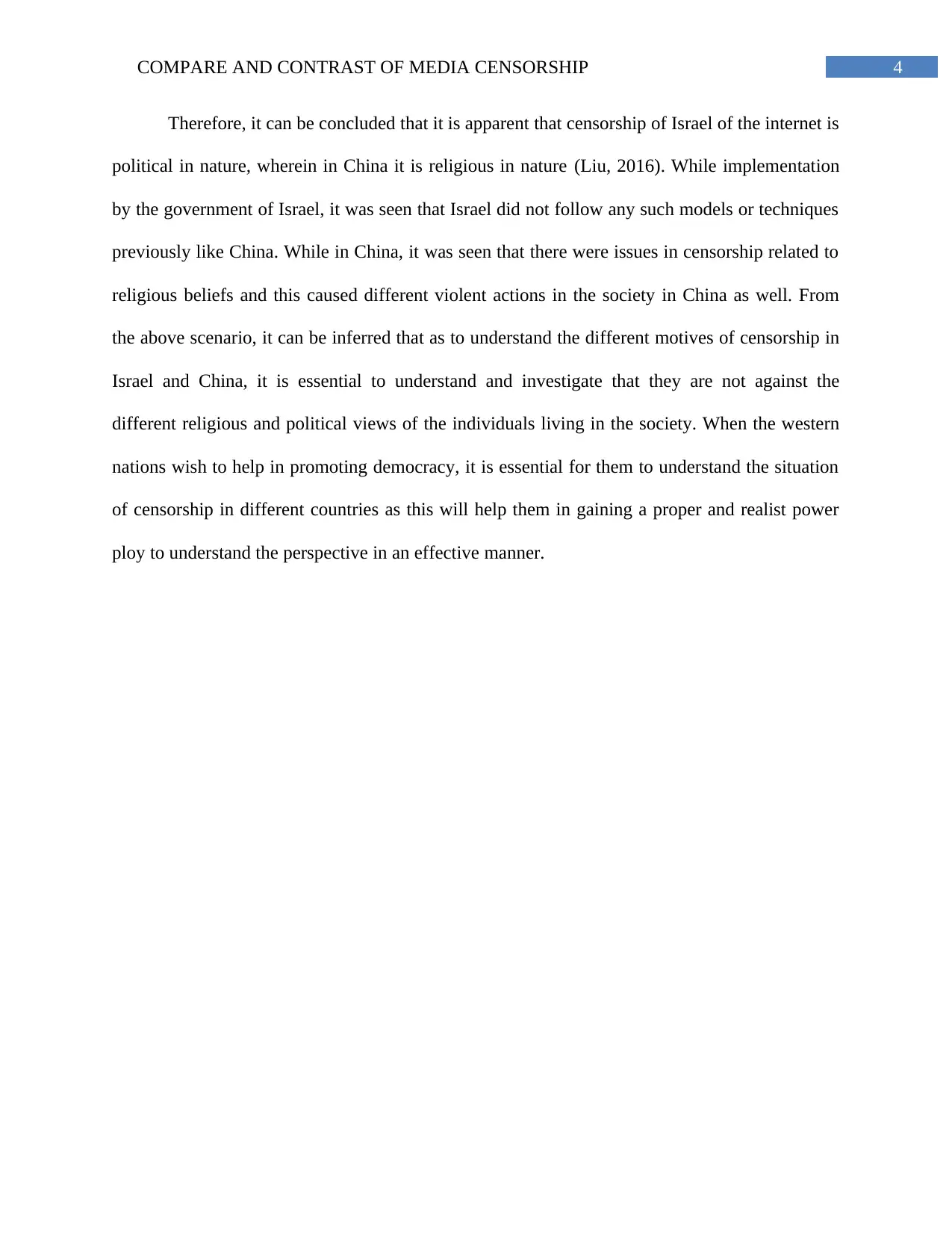
4COMPARE AND CONTRAST OF MEDIA CENSORSHIP
Therefore, it can be concluded that it is apparent that censorship of Israel of the internet is
political in nature, wherein in China it is religious in nature (Liu, 2016). While implementation
by the government of Israel, it was seen that Israel did not follow any such models or techniques
previously like China. While in China, it was seen that there were issues in censorship related to
religious beliefs and this caused different violent actions in the society in China as well. From
the above scenario, it can be inferred that as to understand the different motives of censorship in
Israel and China, it is essential to understand and investigate that they are not against the
different religious and political views of the individuals living in the society. When the western
nations wish to help in promoting democracy, it is essential for them to understand the situation
of censorship in different countries as this will help them in gaining a proper and realist power
ploy to understand the perspective in an effective manner.
Therefore, it can be concluded that it is apparent that censorship of Israel of the internet is
political in nature, wherein in China it is religious in nature (Liu, 2016). While implementation
by the government of Israel, it was seen that Israel did not follow any such models or techniques
previously like China. While in China, it was seen that there were issues in censorship related to
religious beliefs and this caused different violent actions in the society in China as well. From
the above scenario, it can be inferred that as to understand the different motives of censorship in
Israel and China, it is essential to understand and investigate that they are not against the
different religious and political views of the individuals living in the society. When the western
nations wish to help in promoting democracy, it is essential for them to understand the situation
of censorship in different countries as this will help them in gaining a proper and realist power
ploy to understand the perspective in an effective manner.
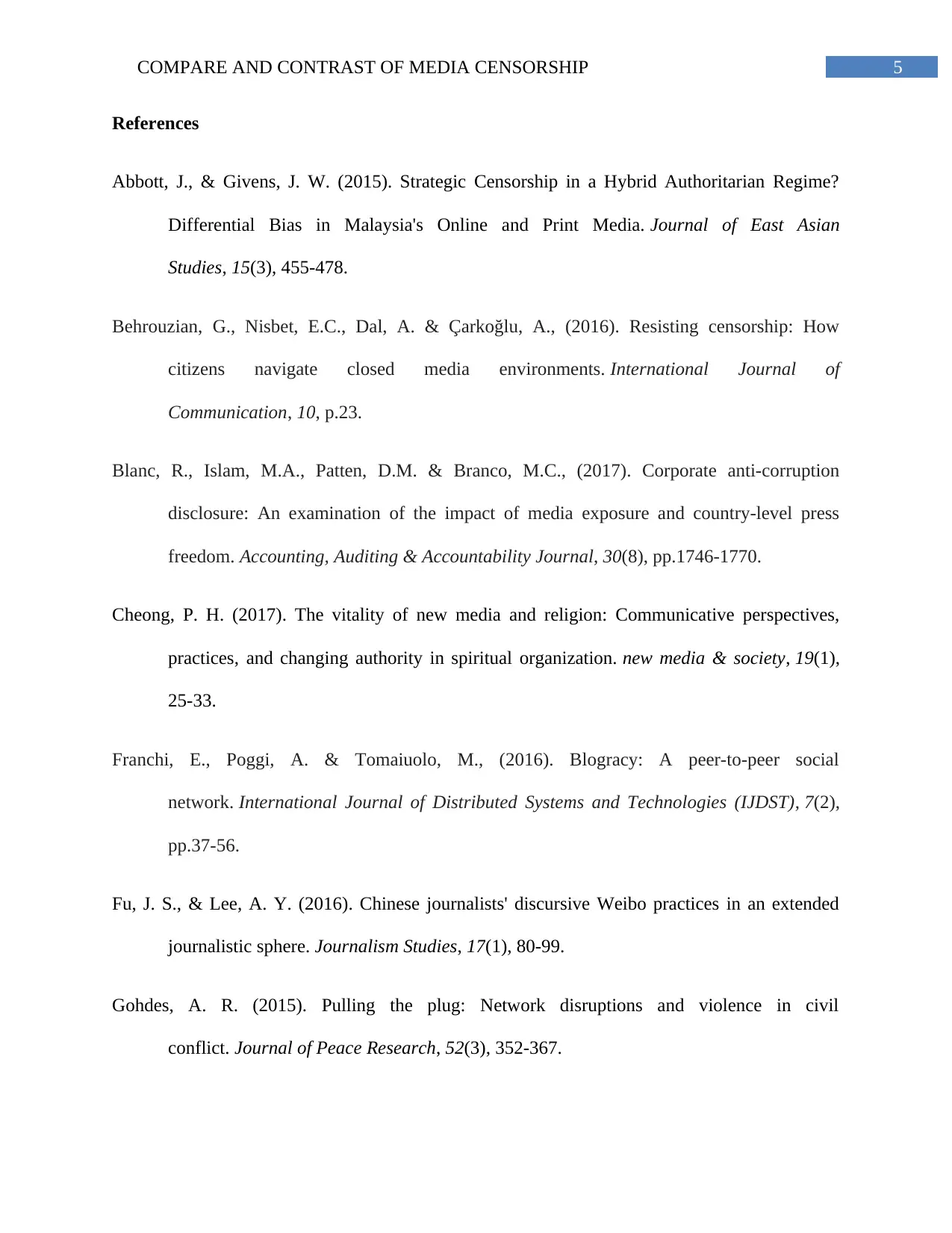
5COMPARE AND CONTRAST OF MEDIA CENSORSHIP
References
Abbott, J., & Givens, J. W. (2015). Strategic Censorship in a Hybrid Authoritarian Regime?
Differential Bias in Malaysia's Online and Print Media. Journal of East Asian
Studies, 15(3), 455-478.
Behrouzian, G., Nisbet, E.C., Dal, A. & Çarkoğlu, A., (2016). Resisting censorship: How
citizens navigate closed media environments. International Journal of
Communication, 10, p.23.
Blanc, R., Islam, M.A., Patten, D.M. & Branco, M.C., (2017). Corporate anti-corruption
disclosure: An examination of the impact of media exposure and country-level press
freedom. Accounting, Auditing & Accountability Journal, 30(8), pp.1746-1770.
Cheong, P. H. (2017). The vitality of new media and religion: Communicative perspectives,
practices, and changing authority in spiritual organization. new media & society, 19(1),
25-33.
Franchi, E., Poggi, A. & Tomaiuolo, M., (2016). Blogracy: A peer-to-peer social
network. International Journal of Distributed Systems and Technologies (IJDST), 7(2),
pp.37-56.
Fu, J. S., & Lee, A. Y. (2016). Chinese journalists' discursive Weibo practices in an extended
journalistic sphere. Journalism Studies, 17(1), 80-99.
Gohdes, A. R. (2015). Pulling the plug: Network disruptions and violence in civil
conflict. Journal of Peace Research, 52(3), 352-367.
References
Abbott, J., & Givens, J. W. (2015). Strategic Censorship in a Hybrid Authoritarian Regime?
Differential Bias in Malaysia's Online and Print Media. Journal of East Asian
Studies, 15(3), 455-478.
Behrouzian, G., Nisbet, E.C., Dal, A. & Çarkoğlu, A., (2016). Resisting censorship: How
citizens navigate closed media environments. International Journal of
Communication, 10, p.23.
Blanc, R., Islam, M.A., Patten, D.M. & Branco, M.C., (2017). Corporate anti-corruption
disclosure: An examination of the impact of media exposure and country-level press
freedom. Accounting, Auditing & Accountability Journal, 30(8), pp.1746-1770.
Cheong, P. H. (2017). The vitality of new media and religion: Communicative perspectives,
practices, and changing authority in spiritual organization. new media & society, 19(1),
25-33.
Franchi, E., Poggi, A. & Tomaiuolo, M., (2016). Blogracy: A peer-to-peer social
network. International Journal of Distributed Systems and Technologies (IJDST), 7(2),
pp.37-56.
Fu, J. S., & Lee, A. Y. (2016). Chinese journalists' discursive Weibo practices in an extended
journalistic sphere. Journalism Studies, 17(1), 80-99.
Gohdes, A. R. (2015). Pulling the plug: Network disruptions and violence in civil
conflict. Journal of Peace Research, 52(3), 352-367.
⊘ This is a preview!⊘
Do you want full access?
Subscribe today to unlock all pages.

Trusted by 1+ million students worldwide
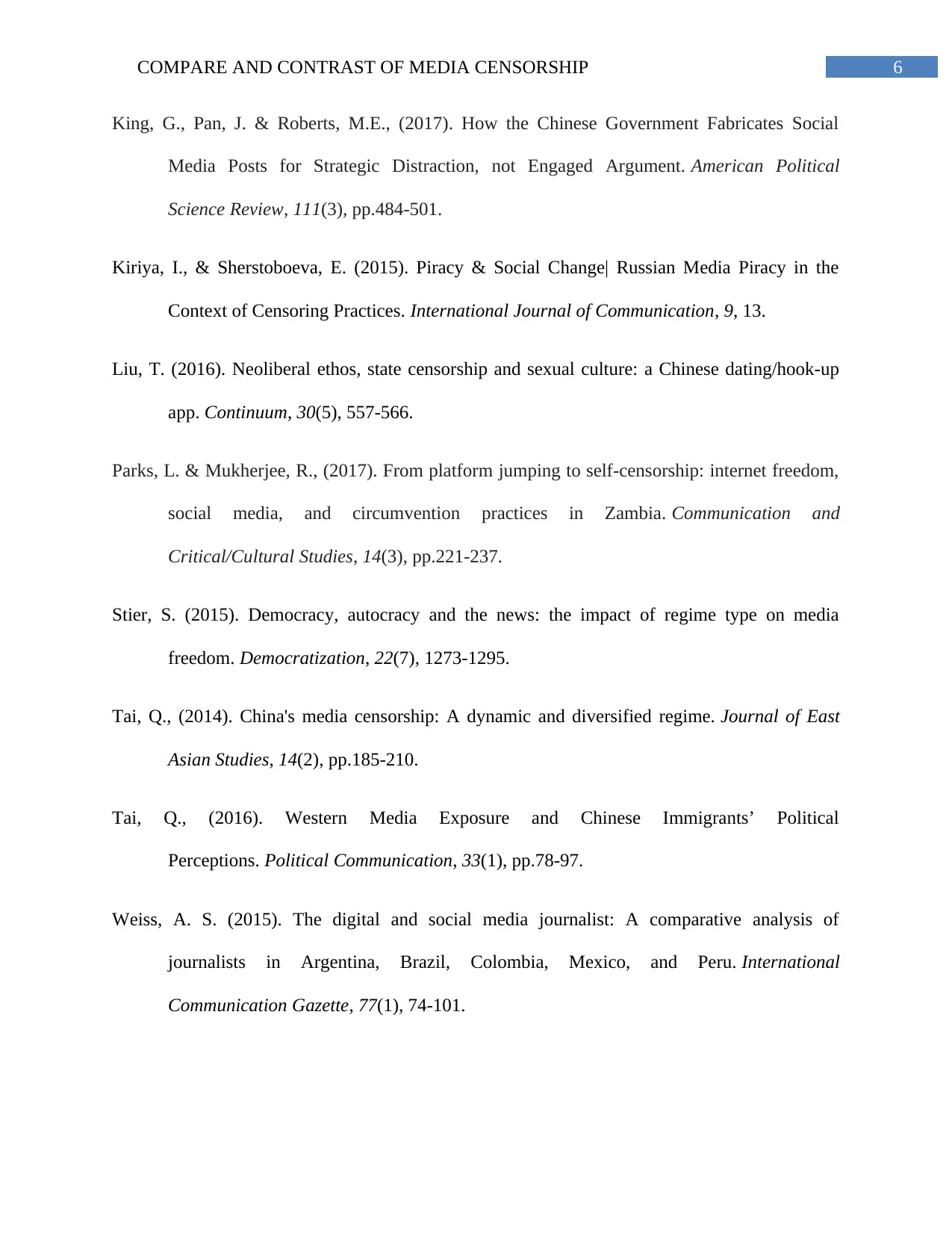
6COMPARE AND CONTRAST OF MEDIA CENSORSHIP
King, G., Pan, J. & Roberts, M.E., (2017). How the Chinese Government Fabricates Social
Media Posts for Strategic Distraction, not Engaged Argument. American Political
Science Review, 111(3), pp.484-501.
Kiriya, I., & Sherstoboeva, E. (2015). Piracy & Social Change| Russian Media Piracy in the
Context of Censoring Practices. International Journal of Communication, 9, 13.
Liu, T. (2016). Neoliberal ethos, state censorship and sexual culture: a Chinese dating/hook-up
app. Continuum, 30(5), 557-566.
Parks, L. & Mukherjee, R., (2017). From platform jumping to self-censorship: internet freedom,
social media, and circumvention practices in Zambia. Communication and
Critical/Cultural Studies, 14(3), pp.221-237.
Stier, S. (2015). Democracy, autocracy and the news: the impact of regime type on media
freedom. Democratization, 22(7), 1273-1295.
Tai, Q., (2014). China's media censorship: A dynamic and diversified regime. Journal of East
Asian Studies, 14(2), pp.185-210.
Tai, Q., (2016). Western Media Exposure and Chinese Immigrants’ Political
Perceptions. Political Communication, 33(1), pp.78-97.
Weiss, A. S. (2015). The digital and social media journalist: A comparative analysis of
journalists in Argentina, Brazil, Colombia, Mexico, and Peru. International
Communication Gazette, 77(1), 74-101.
King, G., Pan, J. & Roberts, M.E., (2017). How the Chinese Government Fabricates Social
Media Posts for Strategic Distraction, not Engaged Argument. American Political
Science Review, 111(3), pp.484-501.
Kiriya, I., & Sherstoboeva, E. (2015). Piracy & Social Change| Russian Media Piracy in the
Context of Censoring Practices. International Journal of Communication, 9, 13.
Liu, T. (2016). Neoliberal ethos, state censorship and sexual culture: a Chinese dating/hook-up
app. Continuum, 30(5), 557-566.
Parks, L. & Mukherjee, R., (2017). From platform jumping to self-censorship: internet freedom,
social media, and circumvention practices in Zambia. Communication and
Critical/Cultural Studies, 14(3), pp.221-237.
Stier, S. (2015). Democracy, autocracy and the news: the impact of regime type on media
freedom. Democratization, 22(7), 1273-1295.
Tai, Q., (2014). China's media censorship: A dynamic and diversified regime. Journal of East
Asian Studies, 14(2), pp.185-210.
Tai, Q., (2016). Western Media Exposure and Chinese Immigrants’ Political
Perceptions. Political Communication, 33(1), pp.78-97.
Weiss, A. S. (2015). The digital and social media journalist: A comparative analysis of
journalists in Argentina, Brazil, Colombia, Mexico, and Peru. International
Communication Gazette, 77(1), 74-101.
1 out of 7
Related Documents
Your All-in-One AI-Powered Toolkit for Academic Success.
+13062052269
info@desklib.com
Available 24*7 on WhatsApp / Email
![[object Object]](/_next/static/media/star-bottom.7253800d.svg)
Unlock your academic potential
Copyright © 2020–2025 A2Z Services. All Rights Reserved. Developed and managed by ZUCOL.




